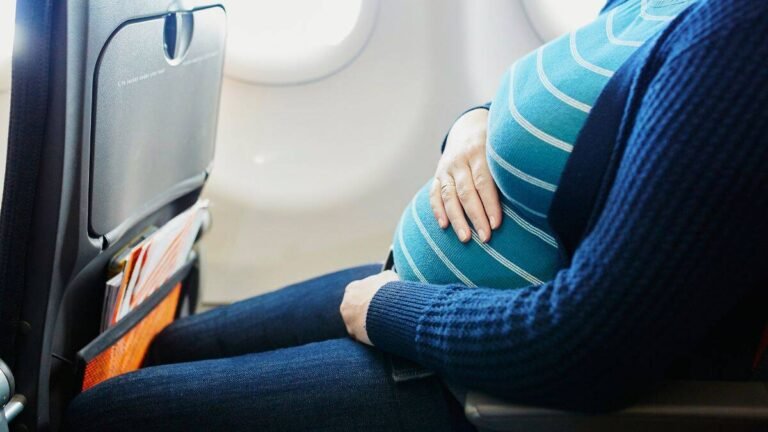Sharing is caring!
Air travel while holding a baby can be exciting and stressful, especially if it’s your first pregnancy or your first flight. Whether for leisure, work or meeting family and friends, flying during pregnancy needs special care to guarantee safety and convenience for both the expectant mother and the unborn child.
In this guide, we’ll share important tips and factors for an expectant mother to consider when planning to fly, from talking to healthcare providers and getting good deals on tickets to making sure her trip is as comfortable as possible .
Discuss air travel with your doctor
Always check with your healthcare provider before booking any flight. Every pregnancy is unique and needs individual advice from your doctor based on your medical history, how far along you are in your pregnancy and any risks associated with flying.
Normally, when a woman is inside second semester (from week 13 to week 26), can be approved for air travel. This is because the morning sickness has generally stopped and there is no high risk of preterm labor. Even so, if you have health problems such as high blood pressure, diabetes or have previously given birth prematurely, you may need to take extra precautions during the flight or delay your trip altogether.
Additionally, make sure you have all necessary vaccinations for your final destination and a list of medications that are safe to use to handle common travel concerns such as sickness or headaches. It is also important to get a letter from your doctor stating when your due date will be and confirming that it is safe for you to travel. Some airlines ask for this document, particularly if you are in the last stages of pregnancy.
Save on ticket prices to spend on your next bundle of joy
Budgeting for a baby isn’t easy and saving on travel costs can always help. Luckily, there are a few ways to save money when you fly so more of your money goes towards your future bundle of joy.
To find the cheapest options, use online fare comparison tools like Google Flights. These will show you prices from multiple airlines and travel dates. Look online for one complete Google Flights guide that will help you get the most out of this tool. In addition, airlines usually provide tickets at lower prices for those purchased well in advance of the date of travel. If your travel schedule allows for flexibility, you can find cheaper fares by choosing less popular travel days, such as mid-week flights.
You can also set fare alerts on travel websites. When prices drop for your chosen routes, they will alert you and you can then book at the lowest possible cost. Also, check if using points or miles from an airline rewards program or credit card could help lower the cost of your flights. Some credit cards may also provide travel insurance, which could be beneficial during pregnancy.
Choosing the right seat and airline
About 70% of pregnancies include low back pain, abdominal pain, and pelvic girdle pain. The thing is, pregnancy can be pretty uncomfortable on land, but in the sky. It is of utmost importance to make yourself as comfortable as possible. The seat and airline you choose can greatly affect your travel experience.
An aisle seat is a good choice because it allows you to have easier access to the toilet and gives you the freedom to stretch your legs, which is important. Seats located in bulkheads or exit rows can also be selected for extra legroom. Researching airline rules regarding pregnant passengers is also crucial because some airlines place limits on travel after a certain stage of pregnancy, and policies can vary widely.
Looking for airlines with amenities like extra legroom, comfortable seats, and in-flight entertainment can help make your trip more enjoyable. These amenities can help reduce the hassle of flying during pregnancy, making it a better trip for you.
Staying comfortable during the flight
Wearing loose, breathable clothing as well as wearing comfortable shoes can make a big difference in feeling good. Wearing compression socks can help stop swelling and reduce the risk of deep vein thrombosis (DVT). Drink plenty of water before and during the flight, as it is often observed that dehydration can occur more easily when we are in the air. It is recommended that you do not have caffeine or drinks with a lot of sugar, because they can also lead to dehydration.
Walking on the treadmill every hour, even for a short time, can promote blood circulation and reduce the chances of DVT. If you can’t walk, doing light exercises like moving your ankles in circles or pushing your legs up and down while sitting could still be helpful. To avoid feeling uncomfortable and bloated during a long flight, it’s a good idea to eat light meals before boarding and bring healthy snacks with you. To add more convenience to your trip, you can choose not to eat foods that are high in salt or can cause gas. Taking a neck pillow along with an eye mask and blanket can help you sleep better on the plane so that when you land at your final destination, you’ll feel less tired and more relaxed.
Conclusion
Air travel during pregnancy can be safe and enjoyable if you plan properly and take the necessary precautions. You should consult your healthcare provider, choose the right seat and airline, and stay as comfortable as possible throughout your flight journey. Remember to listen to your body’s signals, stay up to date with pregnancy information, and always prioritize staying healthy while traveling.
Disclosure: collective post
Thanks for reading – if you enjoyed this content, please consider buying me a coffee here
the browse my Amazon wishlist
I really appreciate your support and it helps keep the site up and running for my time too 🙂
